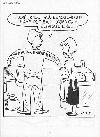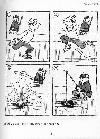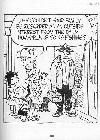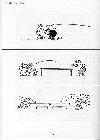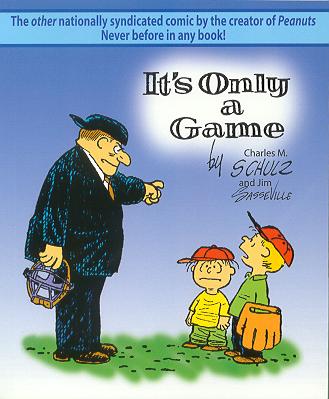
It's Only a Game
Charles M. Schulz is the most famous and most influential cartoonist ever, and his Peanuts comic strips
have been reprinted in hundreds of books. Yet few people know that during the late 1950s, during a period of
great creativity, Schulz also produced a second newspaper comics feature. Itís Only a Game took a look at people
and their pastimes, showing us how we win, how we lose, and how we play the game. This long-forgotten work
has been put into a book for the very first time, in the collection, Itís Only a Game.
This treasure trove of lost Schulz material was dug up at a time when interest in Schulz was running high.
It joined projects such as The Complete Peanuts, Liíl Beginnings (reprinting Schulzís pre-Peanuts series, Liíl Folks),
and Peanuts: The Art of Charles M. Schulz , all of which focused popular and critical attention on Schulzís work.
People who know Peanuts know that sports was a favorite topic, with Charlie Brown, Snoopy and the gang regularly
involved in baseball, football and hockey. Itís Only a Game was a single-panel gag feature that covered all that and more:
bowling, fishing, golf, tennis and every recreational activity from Monopoly to rodeo. And because Schulz was an avid
bridge player at the time, a good percentage of the cartoons involve that popular card game.
Schulz created the series himself and initially did all the work on it. After the series had run for awhile,
cartoonist Jim Sasseville -- at the time, a professional colleague of Schulz's, who also did "ghost" work on the
Peanuts material that was appearing in Dell comic books -- did the finished artwork based on Schulzís sketches.
During a series of interviews with
editor Derrick Bang, Sasseville chatted extensively about his work on this feature, and his comments run
throughout the book. He also gave About Comics access to some special materials.
Although Sasseville died on November 30, 2005, he lived long enough to see this book completed, and share in
the joy of seeing his involvement with this feature spotlighted, after nearly half a century had passed.
"Working with Jim was great," said Nat Gertler, publisher of About Comics.
"Not only do we get a lot of insight into how the strip was put together and what it was like working with Schulz,
he also gave us access to some of Schulzís roughs for cartoons that were never used."
Schulzís widow, Jean, expressed her enthusiasm for this project. "It is wonderful to see the entire run collected
and to read Jim's reminiscences. Sparky [Charles M. Schulz] spoke highly of Jim's drawing ability,
and in this book I can see what he meant."
Sasseville is no less effusive about Schulzís work on the strip, referring to him as "the best cartoonist ever."
Fans are in for an extra treat, because Itís Only a Game features mainly adults. Since Peanuts, Liíl Folks
and Schulzís illustration work focused on kids, this is a rare chance to see his talents applied to older characters.
It's Only a Game features:
- Full-color front and back covers, which reprint one complete It's Only a Game layout as seen in a typical Sunday comics section;
- A brief introduction that explains the feature's origins;
- The complete run of panel cartoons, from November 3, 1957, through January 11, 1959;
- All the "silent" spot-gag cartoons that appeared as a bonus in the feature's weekly Sunday layout;
- Extensive commentary throughout by originally unbilled "ghost artist" Jim Sasseville;
- Index of cartoons, by sport;
- Brief essays about Schulz and Sasseville, by editor Derrick Bang.
Some sample pages (click on each image to enlarge):


